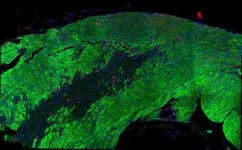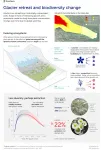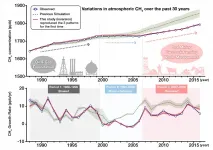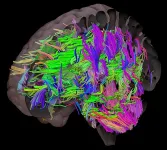Researchers map heart recovery after heart attack with great detail
2021-01-29
(Press-News.org) Researchers from the Hubrecht Institute mapped the recovery of the heart after a heart attack with great detail. They found that heart muscle cells - also called cardiomyocytes - play an important role in the intracellular communication after a heart attack. The researchers documented their findings in a database that is accessible for scientists around the world. This brings the research field a step closer to the development of therapies for improved recovery after heart injury. The results were published in Communications Biology on the 29th of January.
In the Netherlands, an average of 95 people end up in the hospital each day because of a heart attack. During a heart attack, the blood supply to a part of the heart is blocked, for example due to a blood clot in a coronary artery. Attempts to restore the blood supply are made as soon as possible, also known as reperfusion. However, a part of the heart has already been without oxygen for some time. Depending on the size and duration of the infarction, this causes heart muscle cells - also called cardiomyocytes - to die. This can result in the formation of scar tissue, which is stiffer than normal heart tissue and therefore makes it more difficult for the heart to properly contract. This can cause the pumping function of the heart to deteriorate, which can eventually lead to heart failure.
Heart recovery
In other words, insight into the recovery of the heart after a heart attack and how this leads to the formation of scar tissue is extremely important. However, much is still unknown. Reason enough for researchers from the lab of Eva van Rooij to examine this further. They studied how the hearts of mice recover at three different time points following a heart attack. To this end, they used single cell sequencing, a technique that enables the examination of the RNA of individual cells. The researchers generated an enormous dataset with information about the role of different types of cells during the recovery process after a heart attack.
Communication network
Consequently, they used the data to map a communication network. Louk Timmer, researcher on the project, explains: "Cells communicate with each other by secreting molecules. These molecules then trigger the recipient cell to take a specific action, which may be important for the recovery process. We have now mapped with great detail how different cells communicate with each other at different time points after a heart attack. That had never been done so thoroughly before." This communication network is now documented in a database and accessible to scientists around the world.
Formation of scar tissue
Especially the role of cardiomyocytes in the recovery following a heart attack was still largely unknown, partly because of technical difficulties. However, another recent paper from Van Rooij's lab solved these obstacles, allowing the researchers to specifically study the function of cardiomyocytes in the recovery process. "We noticed that at the earliest time point measured after the heart attack, cardiomyocytes were secreting increased amounts of a molecule called B2M. Subsequent experiments showed that the secretion of B2M can result in the activation of so-called fibroblasts - cells responsible for the formation of scar tissue," says Timmer. Cardiomyocytes thus seem to indirectly stimulate the production of scar tissue early in the recovery process. "Intuitively, we already thought that cardiomyocytes play an important role in intracellular communication during heart recovery and it is great that we have now been able to confirm that."
Improve recovery process
When asked about the next steps within this field of research, Timmer emphasizes the importance of additional studies. "Various scientists and experts can use this data, which enables us to gain a better understanding of the cells and molecules that are involved in the recovery of the heart and the way they communicate with each other. Hopefully, we can eventually improve the recovery process, so that people end up with less damage after a heart attack."
INFORMATION:
Publication
"Single-cell transcriptomics following ischemic injury identifies a role for B2M in cardiac repair". Bas Molenaar, Louk T. Timmer, Marjolein Droog, Ilaria Perini, Danielle Versteeg, Lieneke Kooijman, Jantine Monshouwer-Kloots, Hesther de Ruiter, Monika M. Gladka & Eva van Rooij. Communications Biology, 2020.
Eva van Rooij is group leader at the Hubrecht Institute and professor of Molecular Cardiology at the University Medical Center Utrecht.
About the Hubrecht Institute
The Hubrecht Institute is a research institute focused on developmental and stem cell biology. It encompasses 23 research groups that perform fundamental and multidisciplinary research, both in healthy systems and disease models. The Hubrecht Institute is a research institute of the Royal Netherlands Academy of Arts and Sciences (KNAW), situated on Utrecht Science Park. Since 2008, the institute is affiliated with the UMC Utrecht, advancing the translation of research to the clinic. The Hubrecht Institute has a partnership with the European Molecular Biology Laboratory (EMBL). For more information, visit http://www.hubrecht.eu. END
[Attachments] See images for this press release:

ELSE PRESS RELEASES FROM THIS DATE:
2021-01-29
Efforts to understand when corals reproduce have been given a boost thanks to a new resource that gives scientists open access to more than forty years' worth of information about coral spawning.
Led by researchers at Newcastle University, UK, and James Cook University, Australia, the Coral Spawning Database (CSD) for the first time collates vital information about the timing and geographical variation of coral spawning. This was a huge international effort that includes over 90 authors from 60 institutions in 20 countries.
The data can be used by scientists and conservationists to better understand the environmental cues that influence when coral ...
2021-01-29
(Singapore--16:45 p.m. SPT/3:45 EST January 29, 2021)--Two presentations from the ADAURA clinical trial advanced previous research that demonstrated improved disease-fee survival (DFS) outcomes for patients with surgically resected non-small cell lung cancer (NSCLC) receiving osimertinib. The data were reported today at the International Association for the Study of Lung Cancer's 2020 World Conference on Lung Cancer (WCLC) Singapore.
Osimertinib is a third-generation, irreversible, central nervous system-active, epidermal growth factor receptor (EGFR)-tyrosine kinase inhibitor. ADAURA is a randomized Phase III trial comparing adjuvant osimertinib with placebo in patients ...
2021-01-29
Beyond the ski slopes, one of the most iconic symbols of the Alps are the alpine flowers. These plants are not only beautiful -- they are also used in liqueurs and medicines, and they form the foundation of the local food chains. But a recent study in Frontiers in Ecology and Evolution shows that, although plant diversity may initially increase with glacier retreat, many of these species may soon become endangered.
"Our results indicate that plant diversity will ultimately decrease once the glaciers disappear -- and up to 22% of the species we analyzed may locally disappear or even go extinct once the glaciers are gone," says lead author Dr Gianalberto Losapio of Stanford University in the USA. "We show that 'not all species are equal before global warming' and that there are some species ...
2021-01-29
Methane (CH4) is the second most important greenhouse gas after carbon dioxide (CO2). Its concentration in the atmosphere has increased more than twice since the preindustrial era due to enhanced emissions from human activities. While the global warming potential of CH4 is 86 times as large as that of CO2 over 20 years, it stays in the atmosphere for about 10 years, much shorter than more than centuries of CO2. It is therefore expected that emission controlling of CH4 can benefit for relatively short time period toward the Paris Agreement target to limit the global warming well below 2 degrees.
A study by an international team, published ...
2021-01-29
New research from the University of Sheffield has found being overweight is an additional burden on brain health and it may exacerbate Alzheimer's disease.
The pioneering multimodal neuroimaging study revealed obesity may contribute toward neural tissue vulnerability, whilst maintaining a healthy weight in mild Alzheimer's disease dementia could help to preserve brain structure.
The findings, published in The Journal of Alzheimer's Disease Reports, also highlight the impact being overweight in mid-life could have on brain health in older age.
Lead author of the study, Professor Annalena Venneri from the University of Sheffield's Neuroscience Institute and NIHR Sheffield Biomedical Research Centre, ...
2021-01-29
Four million UK patients could benefit annually from genetic testing before being prescribed common medicines, according to new research from the University of East Anglia (UEA) in collaboration with Boots UK and Leiden University (Netherlands).
Researchers looked through 2019 NHS dispensing data across the UK to see how many patients are started on new prescriptions each year that could be potentially optimised by genetic testing.
They studied 56 medicines, including antidepressants, antibiotics, stomach ulcer treatments and painkillers where there are known drug-gene interactions.
And they found that in more than one in five occasions (21.1 ...
2021-01-29
An interdisciplinary team of the Institut national de la recherche scientifique (INRS) used an innovative imaging technique for a better understanding of motor deficits in Amyotrophic Lateral Sclerosis (ALS). The researchers were able to follow the escape behaviour of normal and disease zebrafish models, in 3D. Their results have recently been published in Optica, the flagship journal of the Optical Society (OSA).
Professor Jinyang Liang, expert in ultra-fast imaging and biophotonics, joined an effort with Professor Kessen Patten, specialist in genetics and neurodegenerative diseases. The two groups were able to track the position of ...
2021-01-29
New research from the University of Iowa and University Hospitals Cleveland Medical Center demonstrates that offspring can be protected from the effects of prenatal stress by administering a neuroprotective compound during pregnancy.
Working in a mouse model, Rachel Schroeder, a student in the UI Interdisciplinary Graduate Program in Neuroscience, drew a connection between the work of her two mentors, Hanna Stevens, MD, PhD, UI associate professor of psychiatry and Ida P. Haller Chair of Child and Adolescent Psychiatry, and Andrew A. Pieper, MD, PhD, a former UI faculty member, now Morley-Mather Chair of Neuropsychiatry at Case Western Reserve ...
2021-01-29
-- Experts call for policy reform to improve ethnic equity of socioeconomic opportunity, service provision, and health outcomes. They also call for long-term studies to investigate how structural and institutional racism generate these ethnic inequalities in health.
In 15 out of 17 minority ethnic groups, health-related quality of life in older age (over 55 year-olds) was worse on average for either men, women, or both, than for White British people according to an observational study published in The Lancet Public Health journal.
In five of those groups - Bangladeshi, Pakistani, ...
2021-01-29
Peer-reviewed / Simulation or Modelling / People
A new modelling study has estimated that from 2000 to 2030 vaccination against 10 major pathogens - including measles, rotavirus, HPV and hepatitis B - will have prevented 69 million deaths in low-income and middle-income countries (LMICs).
The study estimated that, as a result of vaccination programmes, those born in 2019 will experience 72% lower mortality from the 10 diseases over their lifetime than if there was no immunisation.
The greatest impact of vaccination was estimated to occur in children under five - mortality from the 10 diseases in ...
LAST 30 PRESS RELEASES:
[Press-News.org] Researchers map heart recovery after heart attack with great detail





